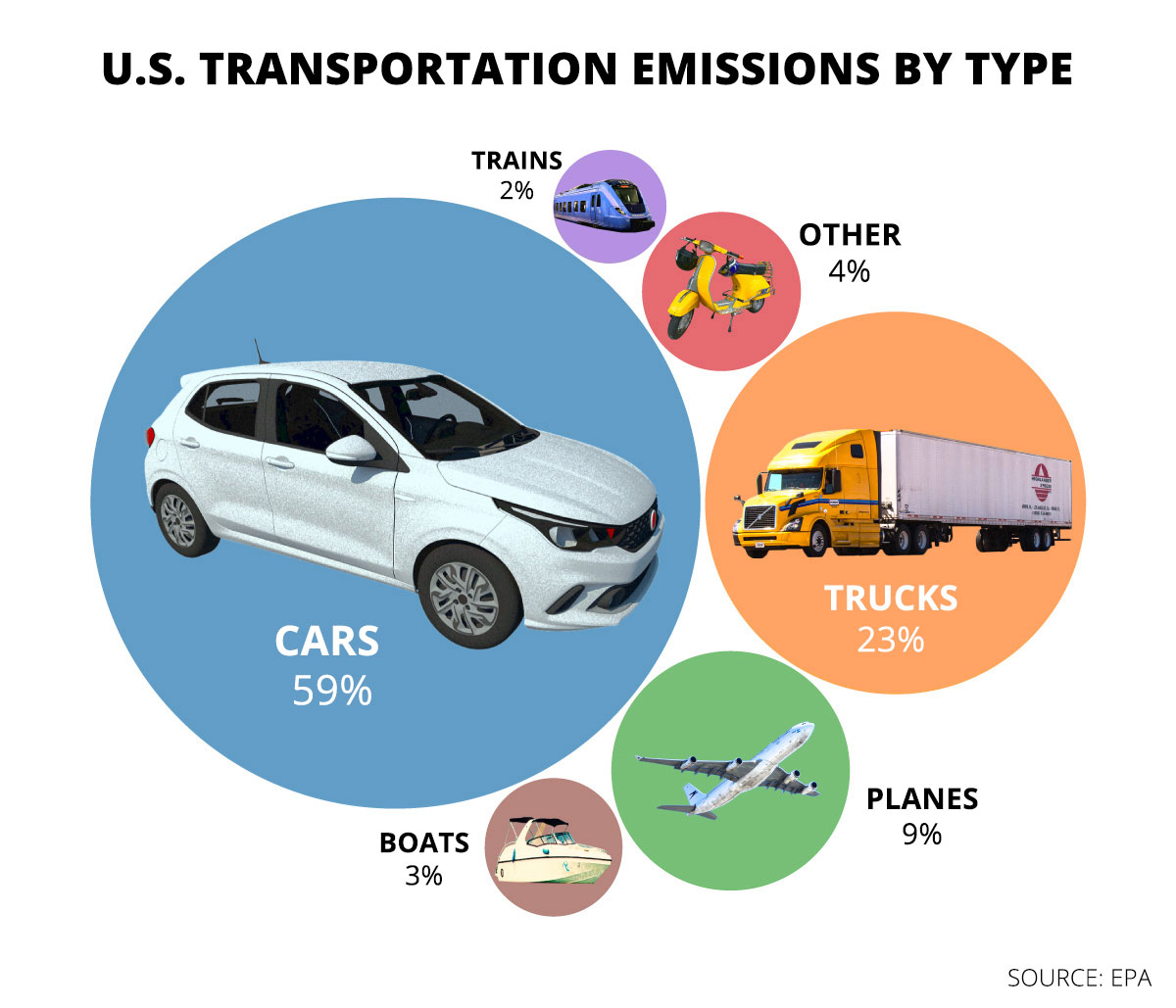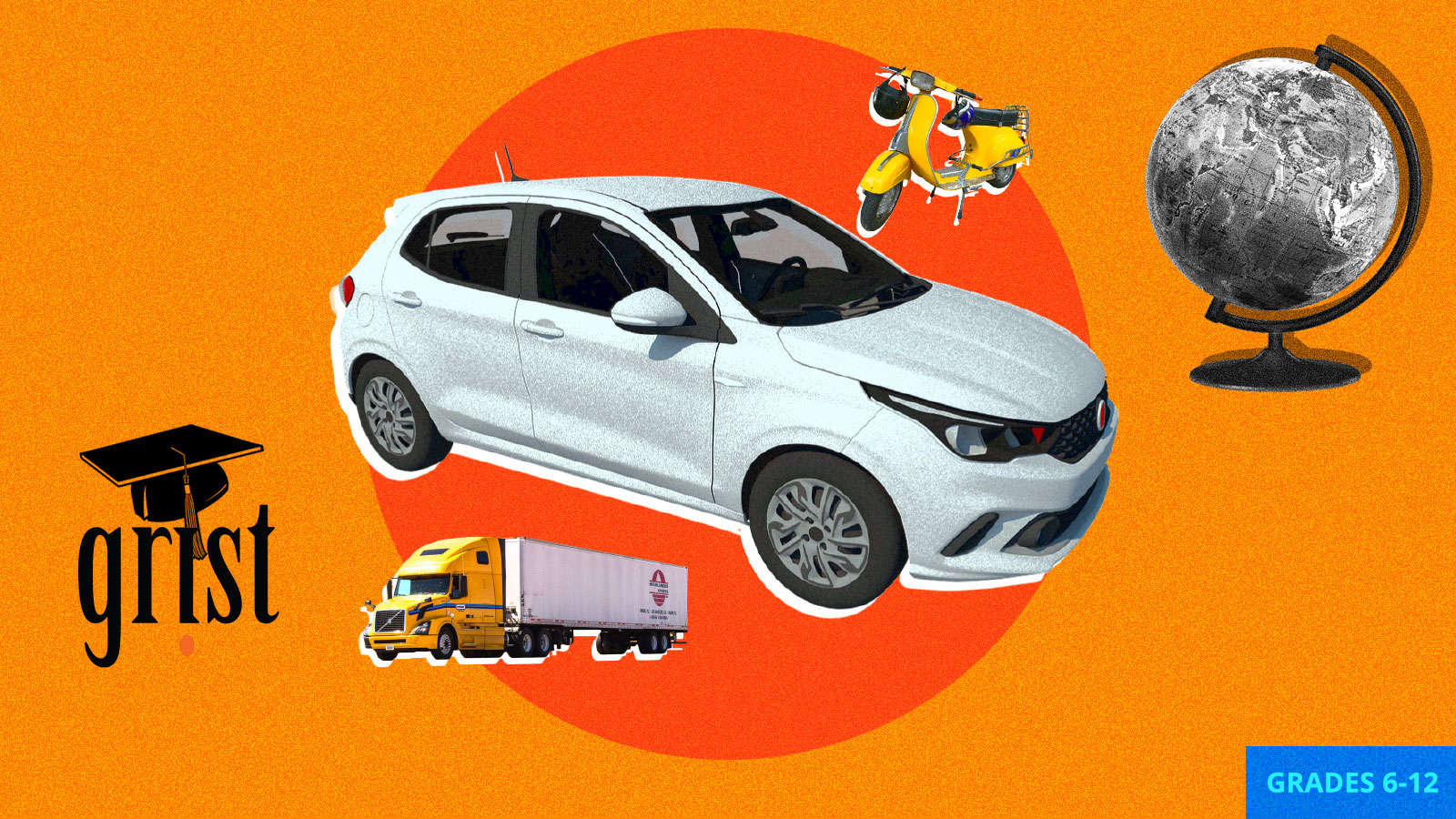This lesson is part of our Climate 101 educational series for parents and K-12 educators.
The transportation sector is one of the biggest reasons why the average temperature on our planet is climbing, a phenomenon you probably know as climate change. In the United States, transportation contributes about a third of the carbon dioxide, or CO2, that the country releases into the atmosphere where it traps heat and causes temperatures to rise. Every year, Americans produce about 1.9 billion metric tons of carbon dioxide from driving cars, flying in planes, and shipping things by road, sea, rail, and air all over the country. That’s the weight of more than 20,000 Washington Monuments.

Grist / Clayton Aldern / Amelia Bates
We want to get that 1.9 billion number closer to zero as soon as possible. But we still need ways to get people and products from one part of the country to another. How do we change the way we move ourselves and our things so that we create fewer planet-warming emissions?
Grist has put together some introductory videos and activities to help you understand some of the ways the transportation sector might go green.
Level: Middle school +
Electric Cars
Electric vehicles are an exciting alternative to the traditional, gas-guzzling, combustion-powered cars. Instead of filling up at the gas station, you simply plug your car into an electric socket and charge the car’s battery. In the past decade, electric cars have gotten better, cheaper, and more popular.
So is an electric car right for your family? It all depends on where you live, how you gets around, and what your family can afford.
Activities:
Research: Look up and see if there are electric vehicle charging stations in your area. If you live in an area where there are very few charging stations, it might be difficult to imagine owning an electric car. Think about all the car trips you normally make: school, work, grocery shopping, even weekend trips and vacations. If your electric car could go 100 miles on a charge, could you still easily make most of these trips?
Do: The “greenness” of your electric vehicle depends on how your region generates electricity. You can find out by typing your ZIP code into the “power profiler” sidebar on this Environmental Protection Agency web page. It will tell you how many pounds of carbon dioxide it takes to produce a megawatt-hour of electricity — the energy equivalent of about 28 gallons of gasoline. We can use this number to compare whether an electric car is better than a gas car in your city.
For our comparison, we’re going to use a 2020 Honda Civic as our gas-powered car, and a 2020 Nissan Leaf as our electric car.
A 2020 Honda Civic gets an estimated 34 miles per gallon. A gallon of gas produces 19.6 pounds of carbon dioxide. This means it takes 0.58 pounds of CO2 to drive one mile in the Honda Civic.
The Nissan Leaf can store 0.062 megawatt-hours of electricity in its battery. The car can drive about 226 miles on one charge. This means it takes 0.00027 megawatt hours of energy to drive a mile. Now we can figure out how much carbon dioxide it takes to drive a mile.
Take the number you found on the Power Profiler website, and multiply it by 0.00027. This will give you the pounds of CO2 that result from a Nissan Leaf driving one mile in your area.
Grist / Jesse Nichols
So … which car produces more CO2 in your city?
Discuss: Would an electric car work with your family’s budget and driving habits? Why or why not?
Walkable cities
Have you ever gotten in the car only to drive a few blocks away? You’re not alone. Americans take a lot of unnecessary car trips. If we could get more people to take the bus, hop on a bike, or simply walk more, we could shave off a big chunk of the U.S.’s transportation-related emissions.
Some neighborhoods are less walkable than others. If you live near a busy road or in a neighborhood far from your favorite hangouts, it can be inconvenient or even dangerous to walk. To get more people out of their cars and walking, we need to think about how our neighborhoods are designed.
Activities:
Research: Look up your address on the Walk Score website. This will give you a ranking based on how easy it is to walk to nearby stores, schools, or parks. If you click “About your score,” you can see which categories your home scores low and high on.
What’s your score? Do you agree with this assessment? Why or why not?
Discuss: Think about all the places you go on a regular basis. Where do you shop for groceries, eat food, or watch movies? What parks do you like to visit? Can you find any alternate places to do these activities that are within walking distance?
Bikes
Bikes are fun, healthy, and climate-friendly forms of transportation. But not everyone owns a bike — or it can be impractical to lug one along for certain types of trips. In some cities, companies offer bikes on the sidewalk that you can just hop on and ride.
Activities:
Research: How does the built environment make people more or less likely to bike? Look up your neighborhood’s Bike Score. This tool grades each neighborhood’s bike-ability based on four factors: safe infrastructure (like bike lanes), hills, the number of gathering places within biking distance, and how many of your neighbors also ride bikes.
Observe: Does your neighborhood have bike lanes? Would you feel safe riding a bike in your neighborhood? How many of your favorite destinations — like parks, restaurants, stores, or museums — are within biking distance? Does your neighborhood have a lot of hills? If it does, would a rentable e-bike make you more likely to ride? The Bike Score website believes that it’s safer to ride on streets that have a lot of bike traffic already. Do you see people riding bikes in your neighborhood?
Discuss: Does your city have a bikeshare or short-term rental program? What are some trips you would take using a bike you own or could rent?
Do: Plan a fun fantasy trip you could take on a bike. Where would you want to go? What would you need to bring? How much time would you need?
Trains
Trains have been around for nearly two centuries, and they’re a promising solution for cutting the country’s transportation emissions. They’re also pretty efficient — meaning they only use a little bit of fuel to carry each rider. Some trains even run on electricity.
But in the United States, our trains are pretty slow and outdated. Can we fix them?
Activities:
Research: Think about the most recent plane trips you have taken. Would it have been possible to take the train instead? How much time would it take? How much would it cost?
Discuss: What might make you want to take a train over a plane? How would you make a train trip a more desirable option compared to an airplane flight?




